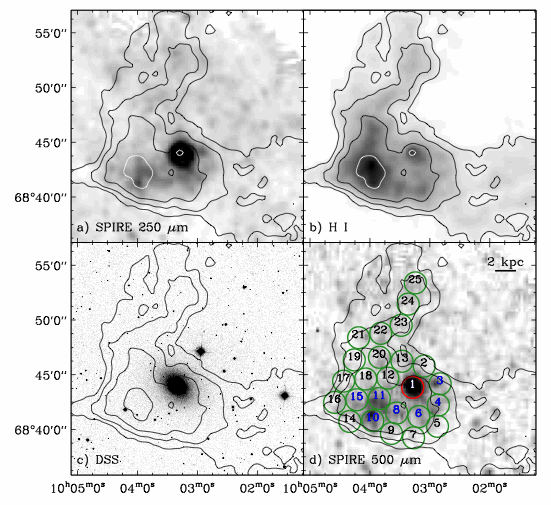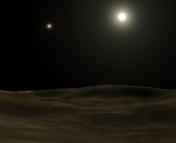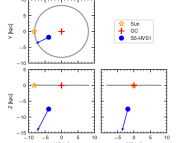Authors: N. Bijas, Chakali Eswaraiah, Panigrahy Sandhyarani, Jessy Jose, Maheswar Gopinathan
First Author’s Institution: Indian Institute of Science Education and Research Tirupati; Jodrell Bank Centre for Astrophysics, University of Manchester
Status: Published in MNRAS [open access]
You’d be forgiven for thinking that astronomy (from the Greek astron for “star” and nomos for “arranging” or “law”) would be largely the study of stars. After all, that’s most of what we see when we look up at the night sky or at pictures released by Hubble or JWST, and quite a few astronomers do spend their lives studying stars. But if we look closer, we find that most of the universe is actually suffused with huge clouds of gas and dust.
Dust may not sound like a particularly exciting topic of study, but it’s extremely important to a wide range of subfields within astronomy. If we want to study anything from the Galactic center to distant galaxy clusters to the Cosmic Microwave Background, we need to be able to characterize the so-called “foreground” dust that lies between us and that object, blocking its light at particular wavelengths. And because dust occupies a large portion of the volume of any given galaxy or cluster, its dynamics and properties are also an excellent tracer of the object as a whole, shedding metaphorical light on astrophysics that might otherwise be obscured.
Spinning footballs
Dust grains in the Milky Way can have a variety of different sizes, shapes, and compositions, and these properties impact how they absorb and emit light. While some grains are mostly spherical, a significant proportion are shaped more like tiny footballs a fraction of a micron across (that’s American football, for our non-US readers). As these oblong, asymmetrical dust grains interact with the Galaxy’s magnetic field, they align with it, inducing a polarizing effect on light that passes through the dust cloud.
Today’s authors look at the polarization of light in and around six different star clusters of varying ages and distances within our Galaxy, shown in the schematic in Figure 1, and use that polarization to infer the properties of the dust present along the line of sight to each cluster. To do this, they use two quantities: the ratios of the percentage of polarized light to the extinction along the line of sight, and to the cluster distance.

Extinction is a measure of how much light from a background object is being absorbed along the line of sight between the object and us. The more dust there is along the line of sight, the higher the extinction, so the extinction is a proxy for the amount of dust. When we divide the polarization fraction of light from a given cluster by its extinction, then, we get a measurement of how many of the dust grains along the line of sight are aligned with the Milky Way’s magnetic field. Similarly, by dividing the polarization fraction by the distance we get a measure of the distribution of the polarizing dust along the line of sight, allowing the authors to build a 3D map of the dust in and around the clusters.
Mapping the Milky Way
The authors use clustering algorithms to separate each star in their field of view into foreground, background, and cluster member stars. This allows them to differentiate the dust along the line of sight to each star into one of two populations: the Interstellar Medium (ISM), which incorporates dust within the galaxy but outside of a star cluster, or the Intracluster Medium (ICM), which is dust within a cluster.
Younger star clusters tend to contain large amounts of leftover gas and dust from the nebulae in which their stars were born, but this dust tends to be dispersed over time as the cluster moves through the galaxy, such that the difference between the amount of dust inside and outside of older clusters is negligible. Because of this, the three younger clusters in the dataset trace the ICM, but the older clusters are treated as tracing the ISM. Foreground stars for all clusters are also ISM tracers. Once they’ve obtained this classification, the authors can then analyze the polarization fraction with respect to extinction and distance for each star in their dataset, in order to investigate the differences between ISM and ICM dust.
The polarization fraction with respect to extinction can be modeled using a power law, Avb, where Av is the extinction and b is an exponential index. The authors find that the shape of this power law is markedly different for ISM vs ICM dust – the index for ISM dust is -0.3, while the index for ICM dust is -0.7. Dust grains align efficiently with the Galactic magnetic field when they are the right size (too big, and they can’t be moved easily; too small, and they’re usually too spherical), and in the presence of strong radiation, which sets the football-shaped dust grains spinning in the same direction. Young star clusters contain massive O- and B-type stars, whose strong stellar winds create chaotic conditions within the cluster, causing dust to misalign with the Galaxy’s magnetic field. All of these factors indicate that dust grains are being much more efficiently aligned with the Galactic magnetic field in the ISM than in the ICM.
Today’s paper gives us a 3D map of dust in the Milky Way along the line of sight to these clusters, and shows that ISM dust is an efficient tracer of the ambient magnetic field. Anyone who wants to study our Galaxy itself, or anything within or beyond it, needs to deal with dust – so the more we know about how it behaves, the better!
Astrobite edited by Kylee Carden
Featured image credit: ESA, NASA, E. Olszewski (University of Arizona)




